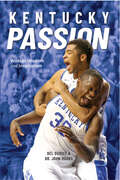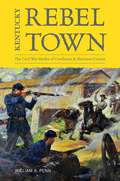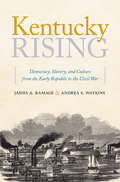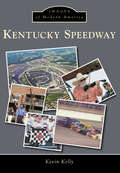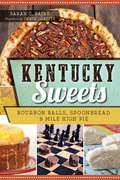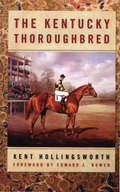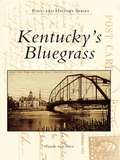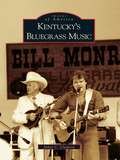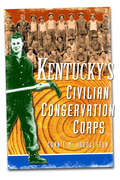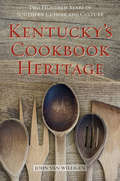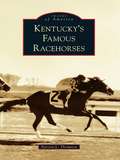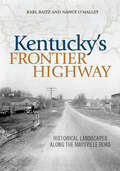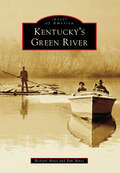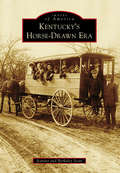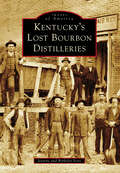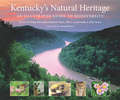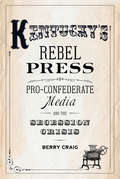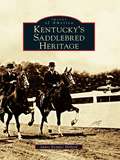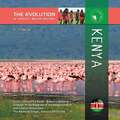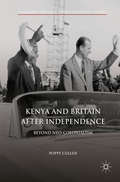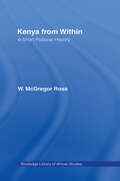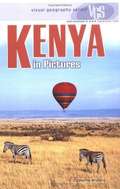- Table View
- List View
Kentucky Passion: Wildcat Wisdom and Inspiration
by John Huang Del DuduitWildcat Wisdom for the Big Blue Nation!For more than a century, the University of Kentucky Wildcats men's basketball team has built a winning tradition that feeds the Big Blue Nation. The history of the winningest program in college basketball is peppered with unforgettable moments and personalities.In Kentucky Passion, Del Duduit and John Huang help fans reexperience some of the most memorable seasons and shots and meet key players and coaches. Readers will learn how they too can rise to challenges and find success through the inspiring stories from Wildcat history. Weekly stories showcasing legendary coaches including Adolph Rupp, Joe B. Hall, Rick Pitino, Tubby Smith, and John Calipari, standout players including John Wall, Kyle Macy, DeAndre Liggins, Goose Givens, and Aaron Harrison, and indelible highs and lows (yes, the BBN still hates Laettner) illustrate the value of persistence, hard work, resiliency, teamwork, and more.Kentucky Passion is for every citizen of the Big Blue Nation and for every sports fan who relishes well-deserved victories, moans at surprise defeats, or wants to learn more about one of the most storied teams in college sports.
Kentucky Rebel Town: The Civil War Battles of Cynthiana and Harrison County
by William A. PennOn April 22, 1861, within weeks of the surrender at Fort Sumter, fresh recruits marched to the Cynthiana, Kentucky, depot -- one of the state's first volunteer companies to join the Confederate army. The soldiers boarded a waiting train as many sympathetic city and county officials cheered. A Confederate flag was raised at the Harrison County courthouse but it was taken down within six months, as the influence of pro-Southern officials diminished. However, this "pestilential little nest of treason" became a battlefield during some of the most dramatic military engagements in the state.In this fascinating book, William A. Penn provides an impressively detailed account of the military action that took place in this Kentucky region during the Civil War. Because of its political leanings and strategic position along the Kentucky Central Railroad, Harrison County became the target of multiple raids by Confederate general John Hunt Morgan. Conflict in the area culminated in the Second Battle of Cynthiana, in which Morgan's men clashed with Union troops led by Major General Stephen G. Burbridge (the "Butcher of Kentucky"), resulting in the destruction of much of the town by fire.Penn draws on dozens of period newspapers as well as personal journals, memoirs, and correspondence from citizens, slaves, soldiers, and witnesses to provide a vivid account of the war's impact on the region. Featuring new maps that clearly illustrate the combat strategies in the various engagements, Kentucky Rebel Town provides an illuminating look at divided loyalties and dissent in Union Kentucky.
Kentucky Rising: Democracy, Slavery, and Culture from the Early Republic to the Civil War
by James A. Ramage Andrea S. WatkinsKentucky's first settlers brought with them a dedication to democracy and a sense of limitless hope about the future. Determined to participate in world progress in science, education, and manufacturing, Kentuckians wanted to make the United States a great nation. They strongly supported the War of 1812, and Kentucky emerged as a model of patriotism and military spirit. Kentucky Rising: Democracy, Slavery, and Culture from the Early Republic to the Civil War offers a new synthesis of the sixty years before the Civil War. James A. Ramage and Andrea S. Watkins explore this crucial but often overlooked period, finding that the early years of statehood were an era of great optimism and progress. Drawing on a wealth of primary and secondary sources, Ramage and Watkins demonstrate that the eyes of the nation often focused on Kentucky, which was perceived as a leader among the states before the Civil War. Globally oriented Kentuckians were determined to transform the frontier into a network of communities exporting to the world market and dedicated to the new republic. Kentucky Rising offers a valuable new perspective on the eras of slavery and the Civil War.This book is a copublication with the Kentucky Historical Society.
Kentucky Speedway (Images of Modern America)
by Kevin KellyThe history of Kentucky Speedway is as colorful as the flags waved from its flag stand and the cars that dart around its 1.5-mile track. The path to its position on NASCAR's Sprint Cup Series schedule included more twists and turns than the roads leading to Sparta, Kentucky. Ultimately, it took Speedway Motorsports Inc. buying the track from its founders in 2008 for developer Jerry Carroll's vision to be realized three years later when the venue hosted its inaugural Quaker State 400. It is all part of the history of a speedway that brought a major-league sport to the Bluegrass State.
Kentucky Stand
by Jere WheelwrightPeriod and regional flavor for a novel of the wilderness that was Kentucky during Revolutionary years; and of a young Marylander who won his spurs fighting with Boone and other frontiersmen beyond the Alleghenies. Young Jim, in a huff because he'd quarrelled with blonde Mary, gained his grandmother's permission to leave for Kentucky, travelled Boone's Wilderness Road to Boonesborough, took part in the defense of the log stockade against Indian attack, and met a frontier girl who contributed to his maturing.
Kentucky Sweets: Bourbon Balls, Spoonbread & Mile High Pie
by Sarah C. BairdKentuckians from frontiersmen to modern-day pastry chefs have put their marks on the state's baking history. Residents of the commonwealth have plenty of rich recipes and time-honored traditions, like pulling parties, where folks would gather to make taffy. Stack cakes originated from Appalachian weddings, where guests would each offer a layer of cake to the bride and groom, who then added the jam to hold the creation together. The decadent Modjeska confection gets its name from a Victorian-era candy maker's crush on a popular Polish actress. Join author Sarah Baird on a whirlwind trip--complete with recipes--that examines the delectable history of unique Kentucky treats from pawpaws to chocolate gravy..
The Kentucky Thoroughbred
by Kent Hollingsworth“Accounts of the sport’s greatest horses and most colorful characters . . . Hollingsworth gives a remarkably complete history of horse racing in America.” —BooklistKent Hollingsworth captures the flavor and atmosphere of the Sport of Kings in the dramatic account of the development of the Thoroughbred in Kentucky. Ranging from frontier days, when racing was conducted in open fields as horse-to-horse challenges between proud owners, to the present, when a potential Triple Crown champion may sell for millions of dollars, The Kentucky Thoroughbred considers ten outstanding stallions that dominated the shape of racing in their time as representing the many eras of Kentucky Thoroughbred breeding. No less colorful are his accounts of the owners, breeders, trainers, and jockeys associated with these Thoroughbreds, a group devoted to a sport filled with high adventure and great hazards.First published in 1976, this popular Kentucky classic has been expanded and brought up to date in this new edition.“Hollingsworth writes with authority and a good deal of polish about an exotic industry in which Kentucky has led the world for at least a century, and about equine feats that today’s horseplayers may find virtually incredible.” —Louisville Courier-Journal
Kentucky Woman
by Norah HessTrapping, drinking corn whiskey, and carousing with squaws--that was what Spencer Atkins called a perfect life. He wanted no part of a wife and children while he could live in his pa's backwoods cabin as a carefree bachelor. Fresh from the poorhouse, Gretchen Ames had barely escaped bonded servitude. Her hardscrabble past a painful memory, she would marry no man who'd refuse her a home and family. Although they were the unlikeliest couple, Spencer and Gretchen found themselves grudgingly sharing a cabin, working side by side, and fighting an attraction neither could deny. ...
Kentucky's Bluegrass (Postcard History Series)
by Wynelle Scott DeeseWithin these pages are vintage postcards, created between 1900 and 1950, that depict an area known across the country as Kentucky's Bluegrass. From its horse farms to its military forts and river commerce, this seventeen county region exemplifies the spirit and pride of Kentucky, and the images preserved on these postcards bring the history of this unique area to life.
Kentucky's Bluegrass Music
by James C. ClaypoolIt is likely that most fans of bluegrass music would concede that no state should be more associated with bluegrass music than Kentucky--and rightly so. Bluegrass music draws its name from the band that Kentuckian Bill Monroe formed during the late 1930s and 1940s. Bill named his band Bill Monroe and The Blue Grass Boys to honor his home state. Eventually, the music these bands and others like them were playing came to be known as bluegrass music. Later, another Kentuckian, Ebo Walker, while playing with the Bowling Green-based bluegrass band, New Grass Revival, coined the phrase "newgrass" to describe the band's progressive style of music. Other Kentuckians such as Bobby and Sonny Osborne, J. D. Crowe, Ricky Skaggs, and Dale Ann Bradley have become bluegrass stars. Some of the musicians from Kentucky covered in this book are quite famous--some are not. Famous or not, all of them have a deep-rooted passion for the music they play.
Kentucky's Civilian Conservation Corps
by Connie M. HuddlestonBy the time Franklin D. Roosevelt took his first oath of office,the Great Depression had virtually gutted the nation's agricultural heartland. In Kentucky, nearly one out of every four men wasunemployed and relegated to a life of poverty, and as quickly as the economy deflated, so too did morality. "The overwhelming majority of unemployed Americans, who are now walking the streets...would infinitely prefer to work," FDR stated in his 1933 appeal to Congress. So began the New Deal and, with it, a glimmer of hope and enrichment for a lost generation of young men.From 1933 up to the doorstep of World War II, the Civilian Conservation Corps employed some 2.5 million men acrossthe country, with nearly 90,000 enrolled in Kentucky. Native Kentuckian and CCC scholar Connie Huddleston chronicles their story with this collection of unforgettable and astonishing photographs that take you to the front lines of the makeshift camps and through the treacherous landscape, adversity, and toil. The handiwork of the Kentucky "forest army" stretches from Mammoth Cave to the Cumberlands, and their legacy is now preserved within these pages.
Kentucky's Cookbook Heritage: Two Hundred Years of Southern Cuisine and Culture
by John van WilligenFood is a significant part of our daily lives and can be one of the most telling records of a time and place. Our meals -- from what we eat, to how we prepare it, to how we consume it -- illuminate our culture and history. As a result, cookbooks present a unique opportunity to analyze changing foodways and can yield surprising discoveries about society's tastes and priorities.In Kentucky's Cookbook Heritage, John van Willigen explores the state's history through its changing food culture, beginning with Lettice Bryan's The Kentucky Housewife (originally published in 1839). Considered one of the earliest regional cookbooks, The Kentucky Housewife includes pre--Civil War recipes intended for use by a household staff instead of an individual cook, along with instructions for serving the family. Van Willigen also shares the story of the original Aunt Jemima -- the advertising persona of Nancy Green, born in Montgomery County, Kentucky -- who was one of many African American voices in Kentucky culinary history.Kentucky's Cookbook Heritage is a journey through the history of the commonwealth, showcasing the shifting priorities and innovations of the times. Analyzing the historical importance of a wide range of publications, from the nonprofit and charity cookbooks that flourished at the end of the twentieth century to the contemporary cookbook that emphasizes local ingredients, van Willigen provides a valuable perspective on the state's social history.
Kentucky's Famous Racehorses
by Patricia L. ThompsonCentral Kentucky is home to many magnificent horses and their farms. Although there are numerous places to witness these beautiful animals, including Keeneland, Churchill Downs, Pimlico, and Belmont, their history often gets overwhelmed by their statistics. Images of America: Kentucky's Famous Racehorses goes beyond the numbers and provides insight into the character of these beloved creatures by featuring stories straight from those closest to the horses--the grooms.
Kentucky's Frontier Highway: Historical Landscapes Along the Maysville Road
by Karl Raitz Nancy O'MalleyEighteenth-century Kentucky beckoned to hunters, surveyors, and settlers from the mid-Atlantic coast colonies as a source of game, land, and new trade opportunities. Unfortunately, the Appalachian Mountains formed a daunting barrier that left only two pri
Kentucky's Green River (Images of America)
by Richard Hines Pam HinesNamed for Revolutionary general Nathanael Greene, Kentucky's Green River begins a 384-mile journey at its source near Kings Mountain in Lincoln County, flowing through the Pennyroyal and Western Coal Field regions until its confluence with the Ohio River in Henderson County. Throughout the 1800s, the Green River was a lifeline for valley residents, both in obtaining supplies or transporting products to cities along the Ohio River and destinations as far as New Orleans. Flatboats moved lime, coal, tobacco, and whiskey out of the valley, while rafts of logs were floated to Evansville sawmills. In the 1830s, a series of locks and dams were built on the Green River, permanently raising water levels that finally allowed larger paddle wheel steamers to begin plying upstream, transporting passengers and freight into the river's upper reaches. Referred to as the "era of steamboating," these magnificent boats were numerous until the last of the fleet, the Evansville, burned in 1931. Today, commercial towboats continue moving numerous products along the lower segment of the river, while the upper portion of the river is known as the fourth-most diverse aquatic ecosystem in the United States, making it a destination for outdoor enthusiasts from across the country.
Kentucky's Horse-Drawn Era
by Jeanine Scott Berkeley ScottImages of America: Kentucky's Horse-Drawn Era takes a look at the days when animals--mostly horses and mules--supplied the "horsepower" for daily life in Kentucky. The animals' work included hauling buggies, carriages, wagons, hearses, circus wagons, parade floats, bookmobiles, coal cars, school buses, and everything and everyone in between. This book even has a photograph of a mule team pulling a two-story house down the street of a small town in Kentucky; other unusual images feature a "high-diving" horse and the winners of the Mule Derby. These vintage photographs highlight horses and mules in some of the many roles they filled before the advent of the automobile, the pickup truck, and the tractor.
Kentucky's Lost Bourbon Distilleries (Images of America)
by Berkeley Scott Jeanine ScottKentucky bourbon is world-renowned, and the distilling of this corn-based liquor has deep roots in almost every corner of the state. Hundreds of distilleries dotted the landscape, beginning with the early settlements until 1920, when the vast majority were closed because of Prohibition. Many of the distilleries never reopened and became "lost," with only old photographs left to tell this story of dedicated craftsmanship. In some cases, distilleries reopened during a "bourbon boom" when Prohibition finally ended in 1933, only to falter a few decades later. Some of those distilleries were sold and portions of the properties, like warehouses, reused by the new owner. Despite everything, bourbon distilling remains a major industry in the state--and a world-famous icon for Kentucky. Kentucky's Lost Bourbon Distilleries is dedicated to the many people who worked at distilleries that may be "lost" but are not forgotten.
Kentucky's Natural Heritage: An Illustrated Guide to Biodiversity
by Greg Abernathy Deborah White Ellis L. Laudermilk Marc Evans“[A] beautiful book about a state that has just about everything except a beach: mountains, swamps, rivers, plains, and, of course, the lovely bluegrass.” —Baton Rouge AdvocateKentucky’s abundance of plant and animal life, from the bottomland swamps in the west to the rich Appalachian forests in the east, is extraordinary as well as beautiful. Glades, prairies, forests, wetlands, rivers, and caves form a biologically diverse patchwork that is unique to the state. Kentucky’s Natural Heritage: An Illustrated Guide to Biodiversity provides an essential reference to the remarkable natural history of the commonwealth and is a rallying call for the conservation of this priceless legacy.Kentucky’s ecosystems teem with diverse native species, some of which are found nowhere else in the world. Kentucky’s Natural Heritage brings these sometimes elusive creatures into close view, from black-throated green warblers to lizard skin liverworts. The aquatic systems of the state are home to rainbow darters, ghost crayfish, salamander mussels, and an impressive array of other species that constitute some of the greatest levels of freshwater diversity on the planet.Richly detailed and lavishly illustrated with more than 250 color photos, maps, and charts, Kentucky’s Natural Heritage is the definitive compendium of the commonwealth’s amazing diversity and presents a persuasive argument for the necessity of conservation. Organized by a team from the Kentucky State Nature Preserves Commission, the book is an outgrowth of the agency’s focus on biodiversity protection.“Between its covers, readers will find details of Kentucky’s vanished natural areas and catalogue of the increasingly rare animal, plants and unique habitats that urgently need protection.” —Louisville Courier Journal
Kentucky's Rebel Press: Pro-Confederate Media and the Secession Crisis
by Berry Craig“A history of Kentucky's pro-Confederate press and its decidedly unsuccessful campaign to take the Bluegrass State out of the Union.” —Civil War Books and AuthorsThroughout the Civil War, the influence of the popular press and its skillful use of propaganda was extremely significant in Kentucky. Union and Confederate sympathizers were scattered throughout the border slave state, and in 1860, at least twenty-eight of the commonwealth’s approximately sixty newspapers were pro-Confederate, making the secessionist cause seem stronger in Kentucky than it was in reality. In addition, the impact of these “rebel presses” reached beyond the region to readers throughout the nation.In this compelling and timely study, Berry Craig analyzes the media’s role in both reflecting and shaping public opinion during a critical time in US history. Craig begins by investigating the 1860 secession crisis, which occurred at a time when most Kentuckians considered themselves ardent Unionists in support of the state’s political hero, Henry Clay. But as secessionist arguments were amplified throughout the country, so were the voices of pro-Confederate journalists in the state. By January 1861, the Hickman Courier,Columbus Crescent, and Henderson Reporter steadfastly called for Kentucky to secede from the Union.Kentucky's Rebel Press also showcases journalists who supported the Confederate cause, including editor Walter N. Haldeman, who fled the state after Kentucky’s most recognized Confederate paper, the Louisville Daily Courier, was shut down by Union forces. Exploring an intriguing and overlooked part of Civil War history, this book reveals the importance of the partisan press to the Southern cause in Kentucky.
Kentucky's Saddlebred Heritage (Images of America)
by James Kemper MillardLong associated with fine Thoroughbred horses, Kentucky's Bluegrass region is also home to America's oldest indigenous breed: the American Saddlebred horse. A composite of several breeds, the Saddlebred was developed by 18thcentury colonists who sought a goodlooking, sensible, adaptable, and comfortable animal to ride and drive. These traits made it the mainstay of the Confederate cavalry during the Civil War and the choice mount of many generals on both sides. As the Industrial Revolution replaced the need for working horse power, the Saddlebred evolved naturally into recreational activities. Affectionately known as "peacock of the show ring," the Saddlebred's beauty, expression, and athleticism epitomize the essence of a show horse. In many ways, the breed's history parallels that of America and unfolds in pictures in Kentucky's Saddlebred Heritage.
Kenya (The Evolution of Africa's Major Nations)
by Jim CorriganMany anthropologists believe the human species originated in Kenya's Rift Valley, where hominid skulls more than 2 million years old have been discovered. That fact alone would make Kenya an important place. But this East African nation has many other extraordinary characteristics: diverse terrain, a remarkable variety of plant and animal life, and a fascinating blend of cultures and languages among its people. The political system in Kenya is far from ideal. Historically, government corruption has been a major problem. However, the country adopted a new constitution in 2010 and is considered one of the most stable in Africa. Kenya has a free press and multiple political parties that compete in national elections. The country has also been fortunate to escape the chaos that has affected many neighboring countries in East Africa.
Kenya and Britain after Independence
by Poppy CullenThis book explores British post-colonial foreign policy towards Kenya from 1963 to 1980. It reveals the extent and nature of continued British government influence in Kenya after independence. It argues that this was not simply about neo-colonialism, and Kenya's elite had substantial agency to shape the relationship. The first section addresses how policy was made and the role of High Commissions and diplomacy. It emphasises contingency, with policy produced through shared interests and interaction with leading Kenyans. It argues that British policy-makers helped to create and then reinforced Kenya's neo-patrimonialism. The second part examines the economic, military, personal and diplomatic networks which successive British governments sustained with independent Kenya. A combination of interlinked interests encouraged British officials to place a high value on this relationship, even as their world commitments diminished. This book appeals to those interested in Kenyan history, post-colonial Africa, British foreign policy, and forms of diplomacy and policy-making.
Kenya In Pictures (Visual Geography)
by Catherine BrobergA brief overview of Kenya's land, history, government, people, and culture.
Kenyan, Christian, Queer: Religion, LGBT Activism, and Arts of Resistance in Africa (Africana Religions #3)
by Adriaan van KlinkenPopular narratives cite religion as the driving force behind homophobia in Africa, portraying Christianity and LGBT expression as incompatible. Without denying Christianity’s contribution to the stigma, discrimination, and exclusion of same-sex-attracted and gender-variant people on the continent, Adriaan van Klinken presents an alternative narrative, foregrounding the ways in which religion also appears as a critical site of LGBT activism.Taking up the notion of "arts of resistance," Kenyan, Christian, Queer presents four case studies of grassroots LGBT activism through artistic and creative expressions—including the literary and cultural work of Binyavanga Wainaina, the "Same Love" music video produced by gay gospel musician George Barasa, the Stories of Our Lives anthology project, and the LGBT-affirming Cosmopolitan Affirming Church. Through these case studies, Van Klinken demonstrates how Kenyan traditions, black African identities, and Christian beliefs and practices are being navigated, appropriated, and transformed in order to allow for queer Kenyan Christian imaginations.Transdisciplinary in scope and poignantly intimate in tone, Kenyan, Christian, Queer opens up critical avenues for rethinking the nature and future of the relationship between Christianity and queer activism in Kenya and elsewhere in Africa.
